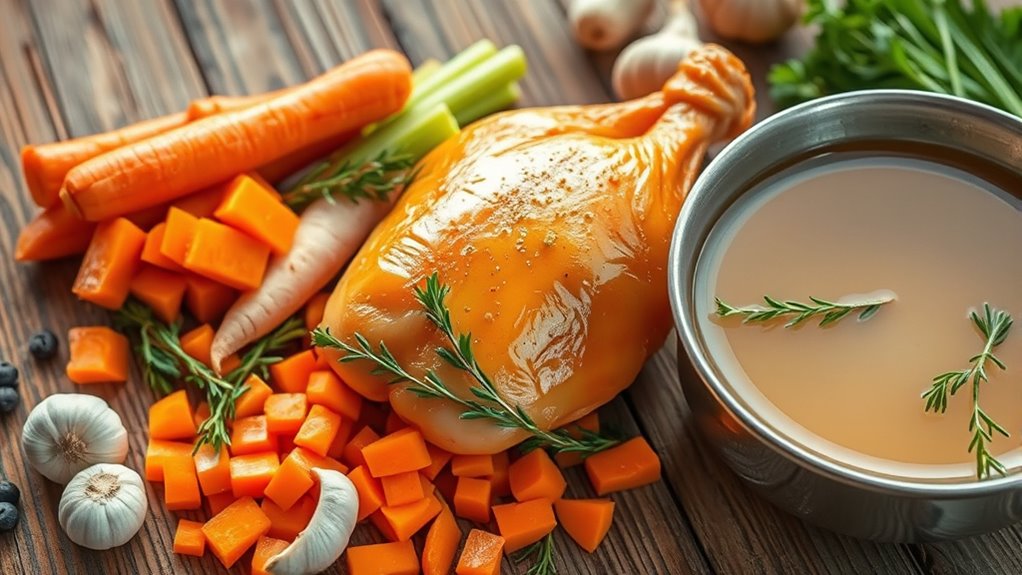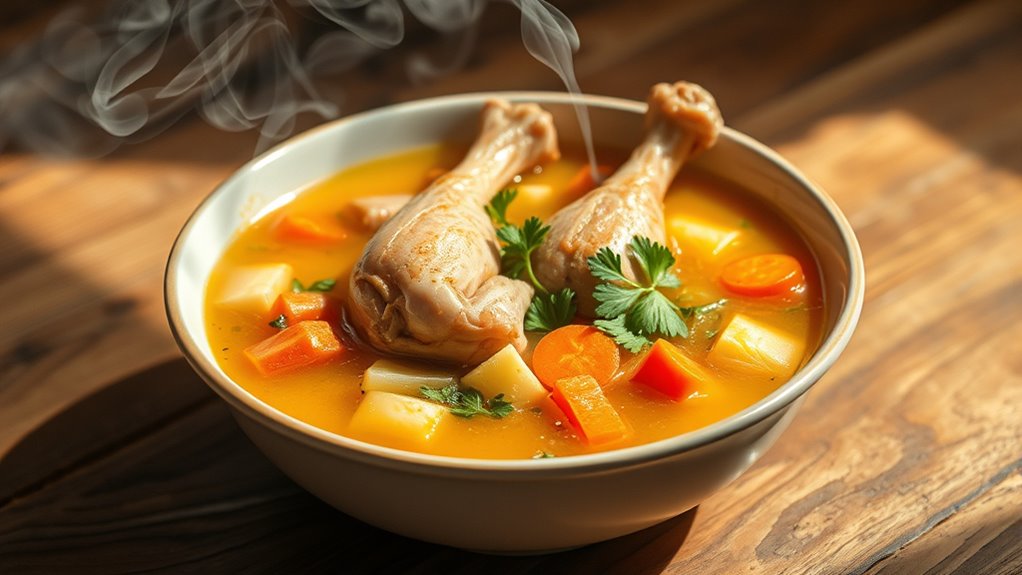Gather a simple, comforting chicken soup by simmering bone-in chicken legs in 8 cups of water with 2 onions, 3 celery stalks, and 3 carrots. Add 4 crushed garlic cloves, 1 bay leaf, 1 teaspoon salt, and ½ teaspoon pepper, then bring to a gentle simmer. Skim the foam for a clear broth, and let the legs cook until tender. Finish with fresh herbs if you like, and tune seasoning to taste—there’s more warmth to discover.
Ingredients and Quantity

Here are the core ingredients and their typical quantities for chicken soup: 1 whole chicken (about 4–5 pounds) or 2–3 pounds bone-in chicken parts, 8 cups water, 2 medium onions (roughly chopped), 3 celery stalks (sliced), 3 carrots (sliced), 4 garlic cloves (crushed), 1 bay leaf, 1 teaspoon salt, ½ teaspoon black pepper, and optional parsley or thyme for aroma.
| Item | Quantity | Notes |
|---|---|---|
| Chicken | 1 whole or 2–3 lb parts | For richer broth |
| Vegetables | Onions, celery, carrots | Flavor base |
| Seasonings | Garlic, bay leaf, salt, pepper | Classic balance |
Nutrition benefits: protein, minerals; ingredient substitutions: bone-in parts, water for stock, herbs for aroma.
Preparations

Now that you’ve got the core ingredients measured, it’s time to prep them for stock. You’ll trim excess fat, rinse chicken legs, and pat dry to remove moisture that can cloud the broth. Slice onions and carrots into even pieces, keeping sizes uniform for steady simmering. Use a gentle hand with herbs, crushing garlic lightly to release aroma without bitterness. Monitor salt carefully, aiming for a balanced base that layers flavor later.
Trim, rinse, and dry chicken; slice aromatics evenly; crush garlic gently to bloom flavor.
- Trimmed, rinsed chicken legs ready for simmer
- Evenly cut aromatics to maximize extraction
- Lightly crushed garlic and herbs for steady aroma
Preparation techniques, Flavor enhancements. This approach keeps the process efficient, precise, and liberating, letting the broth develop depth without clutter or fuss.
Kitchen tools or Kitchenware Required

To prep a satisfying stock, you’ll need a few reliable tools that keep things efficient and steady: a large stockpot or Dutch oven for slow simmering, a sturdy knife and cutting board for clean prep, and a skimmer or spoon for removing impurities as the broth cooks.
| Kitchen gadgets | Cooking utensils |
|---|---|
| Stockpot, Dutch oven, lid | Knife, cutting board, ladle |
| Strainer, tongs | Chef’s knife, peeler, measuring cups |
| Skimmer, slotted spoon | Kitchen shears, spatula |
| Thermometer, timer | Grater, whisk |
These essentials empower you to work freely, swiftly, and confidently, choosing reliable gear that lasts. You’ll feel prepared, focused, and in control as flavors bloom without fuss.
How to Cook

- Plan your cooking process and gather stock tools.
- Simmer chicken bones in water to start the stock.
- Skim off foam gently to keep the broth clear.
- Add aromatics gradually to build depth of flavor.
- Maintain a gentle heat to preserve broth clarity.
- Adjust salt near the end to taste.
- Use a whisked starch mixture to smooth the broth if necessary.
- Taste frequently to guide flavor adjustments.
- Cook at a calm pace to keep meat tender and intact.
- Submerge ingredients evenly for consistent extraction.
- Tweak salt, pepper, and herbs in small increments for balanced seasoning.
How to Serve

When you’re ready to serve, strain the stock to remove solids and skim for a clear, golden liquid. You’ll pour the soup into warm bowls, letting steam rise in a gentle arc. Ladle the broth first, then add tender chicken legs and carrots, ensuring an inviting, balanced portion. Keep portions even to showcase consistency and care. For texture contrast, float a few herb sprigs or a pinch of pepper, inviting aroma without overpowering the base. Present the bowls with clean rims and a simple garnish—fresh parsley or a lemon wedge for brightness. Serving suggestions emphasize comfort and clarity, while presentation ideas focus on accessible beauty. This approach invites freedom of choice, allowing guests to tailor seasoning and add-ins to their liking.
Tips
Now that your bowls look inviting, here are practical tips to keep your Chicken Soup ideally comforting and flavorful.
- Master cooking techniques: simmer gently, skim regularly, and finish with a brief rest to meld flavors without overcooking the chicken.
- Build flavor enhancements: bloom aromatics, balance salt, and add a splash of acid for brightness that lifts the broth.
- Finish with texture: shreds of tender meat, al dente vegetables, and a final taste test to adjust seasoning just before serving.
These steps keep the soup cohesive, nourishing, and freeing—you control the pace, the aroma, and the final bite, affirming your kitchen as a place of deliberate, satisfying flavor.
Food Value and Benefit
Chicken soup is a nourishing dish packed with valuable nutrients derived from its wholesome ingredients. The broth, enriched by simmering chicken legs, extracts collagen, minerals, and protein, creating a soothing and nutrient-dense base. This recipe provides a balanced mix of macronutrients and essential micronutrients that contribute to overall health and wellness.
Food Value of Chicken Soup:
- Rich in high-quality protein from chicken, supporting muscle repair and growth.
- Contains collagen, which promotes joint and skin health.
- Includes a variety of vegetables providing dietary fiber, vitamins, and antioxidants.
- Low in sodium when prepared with low-sodium seasoning, supporting heart health.
- Hydrating broth that aids in maintaining fluid balance.
Benefits of Eating This Recipe:
- Supports immune function thanks to vitamins A and C from vegetables.
- Aids tissue repair and recovery through protein and minerals like zinc and iron.
- Provides gentle hydration, helping to alleviate morning sluggishness.
- Supplies essential minerals such as potassium and phosphorus for electrolyte balance.
- Enhances stamina and recovery after physical activity.
Key Vitamins and Minerals in This Recipe:
- Vitamin A (from carrots and herbs) – supports vision and immune health.
- Vitamin C (from herbs and vegetables) – boosts immune defense and antioxidant protection.
- Potassium (from vegetables and broth) – maintains fluid balance and muscle function.
- Iron (from chicken) – essential for oxygen transport in the blood.
- Zinc (from chicken) – important for immune response and wound healing.
- Phosphorus (from chicken and broth) – contributes to bone health and energy metabolism.
Frequently Asked Questions
Can I Freeze Chicken Legs Before Preparing the Soup?
Yes, you can. A friend froze chicken legs before prepping soup and it worked. Freezing chicken preserves flavor, but thaw thoroughly. When you start, you’ll need to account for extra simmer time, and guarantee safe handling during preparing soup.
Is There a Dairy-Free Version of This Recipe?
Yes, you can make a dairy-free version. Use dairy alternatives like coconut milk or almond milk, add herbs, and keep the broth flavorful. Explore soup variations, ensuring you maintain richness without dairy while preserving freedom in flavor.
How Long Can Leftovers Be Safely Stored in the Fridge?
Leftovers last about 3 to 4 days in the fridge for safe consumption. For ideal leftover storage, cool promptly and store in airtight containers. Prioritize food safety to maintain flavor and guarantee you remain in control of freshness.
Can I Use Bones From a Rotisserie Chicken Instead?
Yes, you can. Using rotisserie bones, flavor enhancement comes from simmering slowly; they’ll yield rich stock, but trim fat and simmer gently to prevent bitterness, then strain. You’ll get a soulful broth that respects your freedom of taste.
What Are Good Substitutions for Common Allergens?
Yes, for common allergens, you can use gluten alternatives like cornstarch or arrowroot, and nut substitutes such as seeds or seeds-based milks; you’ll find options that preserve texture and flavor while keeping your dishes approachable, flexible, and free.
